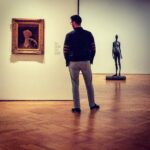
By Reed V. Horth, for ROBIN RILE FINE ART
“One senses the figures as passing by the tree line and, caught in the presence of the wall, turning to gaze upon it almost as a vision.”~ Frederick Hart.
While examining new interpretations of classical themes, Frederick Elliot Hart (American, 1943-1999) continually defaulted to the Greek and Roman ideals of beauty and proportion. Men were muscular, but not overtly so. Women lithe, but neither waiflike nor buxom. The simple beauty of form became more pleasing to him than modern notions of supermodels and bodybuilders. This, in turn, allowed him to create transcendent beings, capable of transporting the viewer to any century he or she wished, while still remaining grounded in the present. The training under Italian stone-master Roger Morigi (1908-1995) at Washington National Cathedral continually inspired visions of past masters and masons in Hart. He said “It’s like touching hands with a generation that is no more.” The overwhelming sensitivity to his surroundings at the Cathedral, which took nearly 100 years to construct and adorn, was a constant reminder that Art is simply an avenue which allows the present to commune with the past.
In almost a direct contradiction to the classical ideals, French Master Auguste Rodin (French, 1840-1917) deconstructed models and plasters in his studio in order to find an entirely new breadth in them and revitalize the waning power of sculpture in the late 19th Century. His powerful “Walking Man” was, in and of itself, a deconstruction and rebuilding of his “St. John the Baptist Preaching”. “Walking Man” was, in turn, deconstructed again to become its simplest of parts, “The Torso”. “Recently I have taken to isolating limbs, the torso” He notes. “Why am I blamed for it? Why is the head allowed and not portions of the body? Every part of the human figure is expressive.”

While some have hypothesized that the “Torso” and “Walking Man” were studies for the “St. John”, photographic and documentary evidence shows that Rodin deconstructed the modele to its simplest parts in an effort to illustrate the decay of time. Rodin presented us with a perfect classical Cathedral and then reduced it to ruins. In doing so, he opened the doorway to modern sculptors who had never imagined a contemporary sculptor endeavoring to create a ruins from the start. This innovation gave rise and inspiration to modernists such as Bourdelle, Archipenko, Brancusi and Arp to further simplify and modernize their own works to an even greater extent. An item of classical beauty can seen as a broken rock to another set of eyes.

“Man’s naked form… belongs to no particular moment in history; it is eternal, and can be looked upon with joy by the people of all ages.” ~Auguste Rodin (1840-1917)
Where Rodin opened the doorway for modern artists to explore simpler forms in art, architecture, writing and music, Hart called for a return to the classical precepts of beauty. According to Hart, artists in all genres should have schooling in the classics before they move into the minimalism evocative of the modern world.
Only once you know the rules, can you break them.




